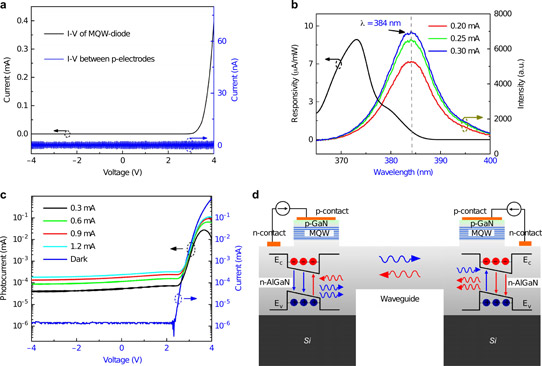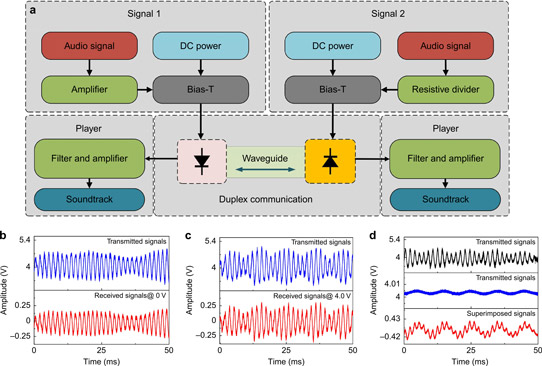- News
14 November 2018
Monolithic near-ultraviolet optoelectronics systems on silicon
Nanjing University of Posts and Telecommunications in China has been working on monolithic near-ultraviolet (UV) optoelectronic combinations of indium gallium nitride (InGaN) multiple quantum well (MQW) diodes connected by waveguides on silicon [Yongjin Wang et al, Light: Science & Applications, vol7, p83, 2018]. The diode devices were able to both generate and detect light signals encoding an audio stream in a real-time full-duplex set up.
The researchers comment: “The self-generated photocurrent opposes a change in the injection current that produced it, indicating that self-absorption may be associated with the efficiency droop phenomenon of light-emitting diodes under high-injection conditions.” On the application side, they see “great potential for diverse applications, such as UV sensing, curing, sterilization, and on-chip power monitoring” from monolithic multicomponent systems.
A buffer of step-graded aluminium nitride (AlN) and aluminium gallium nitirde (AlGaN) layers was grown on (111) silicon. Then, a thick n-Al0.05Ga0.95 layer was followed by a superlattice of 30 pairs of In0.02Ga0.98N/Al0.10Ga0.90N. The active light-emitting region consisted of five InGaN quantum wells separated by Al0.10Ga0.90N barriers. The indium content of the 3nm-thick wells is described as “low”. The p-side of the device was completed with 80nm p-Al0.05Ga0.95N and a 10nm p-GaN contact.
The material was fabricated into two diode devices connected by a 8μm-wide 130μm-long suspended waveguide. The p-electrodes were circular with 120μm diameter. One of the electrodes was of ring form to allow the devices to be distinguished for easy identification. The n- and p-electrodes were nickel/silver. The large refractive index difference between the III-nitride material and air confined light to the plane of the waveguide. The waveguide suspension was achieved by locally removing the silicon substrate using back-side etching.

Figure 1: Optical and electrical performance of monolithic multi-component system. a Measured current–voltage (I–V) curves. b Electroluminescence spectra and spectral responsivity of ring MQW-diode. c Induced photocurrent at circular MQW-diode as a function of injection current of ring MQW-diode. d Schematic of full-duplex light communication of monolithic multi-component system using identical MQW-diodes.
The ring diode had a turn-on voltage of 3.0V, emitting radiation with a dominant peak around 384nm (Figure 1). Removal of the silicon substrate from under the diode shifted the emission wavelength due to changes in the stress built into the material. The researchers found a 40nm overlap of the wavelengths of the emission spectrum and response spectrum of the circular (non-ring) detecting diode.

Figure 2: Full-duplex audio communication using monolithic multicomponent system. a Schematic. b Audio signals received at circular MQW-diode with zero bias. c Audio signals received at circular MQW-diode with bias voltage of 4.0V. d Superimposed signals under simultaneous emission-detection condition.
The researchers used the devices to achieve full-duplex audio communication – i.e. each device was simultaneously a transmitter and receiver (Figure 2). The bias voltage was 4.0V and there was additional driving circuitry to enable encoding and decoding of the signals.
Monolithic near-ultraviolet InGaN
https://doi.org/10.1038/s41377-018-0083-0
(Video with audio link of operation under “Electronic supplementary material” heading.)
The author Mike Cooke is a freelance technology journalist who has worked in the semiconductor and advanced technology sectors since 1997.


